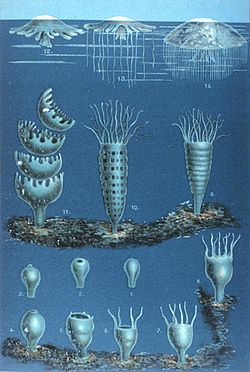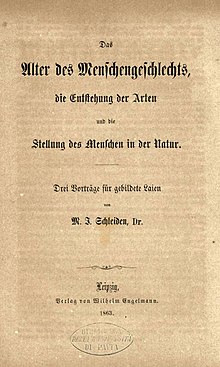Matthias Jakob Schleiden
Matthias Jakob Schleiden | |
|---|---|
 Matthias Jakob | |
| Born | 5 April 1804 |
| Died | 23 June 1881 (aged 77) |
| Nationality | German |
| Alma mater | Heidelberg |
| Known for | Cell theory Coining the term 'cytoblast' |
| Scientific career | |
| Institutions | University of Jena, University of Dorpat |
| Author abbrev. (botany) | Schleid. |
Matthias Jakob Schleiden (German: [maˈtiːas ˈjaːkɔp ˈʃlaɪdn̩];[1][2] 5 April 1804 – 23 June 1881) was a German botanist and co-founder of cell theory, along with Theodor Schwann and Rudolf Virchow. He published some poems and non-scientific work under the pseudonym Ernst.[3]
Career[edit]
Matthias Jakob Schleiden was born in Hamburg. on 5 April 1804. His father was the municipal physician of Hamburg. Schleiden pursued legal studies graduating in 1827. He then established a legal practice but after a period of emotional depression and attempted suicide, he changed professions. The suicide attempt left a prominent scar across his forehead.[4]
He studied natural science at the University of Göttingen in Göttingen, Germany, but transferred to the University of Berlin in 1835 to study plants. Johann Horkel, Schleiden's uncle, encouraged him to study plant embryology.[5]
He soon developed his love for botany and cats into a full-time pursuit. Schleiden preferred to study plant structure under the microscope. As a professor of botany at the University of Jena, he wrote Contributions to our Knowledge of Phytogenesis (1838), in which he stated that all plants are composed of cells. Thus, Schleiden and Schwann became the first to formulate what was then an informal belief as a principle of biology equal in importance to the atomic theory of chemistry. He also recognized the importance of the cell nucleus, discovered in 1831 by the Scottish botanist Robert Brown,[6] and sensed its connection with cell division. In 1838, the two scientists M. J. Schleiden and Theodore Schwann formulated a theory about cellular structure which stated, 'All the living organisms are made up of cells and the cell is the fundamental component of living organismus”. In 1885 Rudolf Virchow stated that all cells are formed from pre-existing cells.
He became a professor of botany at the University of Dorpat in 1863. He concluded that all plant parts are made of cells and that an embryonic plant organism arises from one cell.
He died in Frankfurt am Main on 23 June 1881.[7]

Evolution[edit]
Schleiden was an early advocate of evolution. In a lecture on the "History of the Vegetable World" published in his book Die Pflanze und ihr Leben ("The Plant: A Biography") (1848) was a passage that embraced the transmutation of species.[8] He was one of the first German biologists to accept Charles Darwin's theory of evolution. He has been described as a leading proponent of Darwinism in Germany.[9]
With Die Pflanze und ihr Leben, reprinted six times by 1864, and his Studien: Populäre Vorträge ("Studies: Popular Lectures"), both written in a way that was accessible to lay readers, Schleiden contributed to creating a momentum for popularizing science in Germany.[10]
Schleiden’s popular writings included two volumes of poetry which appeared under the pseudonym “Ernst” in 1858 and 1873.[3] American composer Harriet P. Sawyer set one of his poems to music with her song “Die ersten Tropfen fallen.”[11]
Selected publications[edit]

- The Plant, a Biography (1848) [translated by Arthur Henfrey]
- Encyclopädie der gesammten theoretischen Naturwissenschaften in ihrer Anwendung auf die Landwirthschaft (in German). Braunschweig: Vieweg und Sohn. 1850.
- Grundzüge der wissenschaftlichen Botanik nebst einer methodologischen Einleitung als Anleitung zum Studium der Pflanze (in German). Leipzig: Wilhelm Engelmann. 1861.
- Alter des Menschengeschlechts, die Entstehung der Arten und die Stellung des Menschen in der Natur (in German). Leipzig: Wilhelm Engelmann. 1863.
References[edit]
- ^ Dudenredaktion; Kleiner, Stefan; Knöbl, Ralf (2015) [First published 1962]. Das Aussprachewörterbuch [The Pronunciation Dictionary] (in German) (7th ed.). Berlin: Dudenverlag. pp. 481, 587, 764. ISBN 978-3-411-04067-4.
- ^ Krech, Eva-Maria; Stock, Eberhard; Hirschfeld, Ursula; Anders, Lutz-Christian (2009-12-23). Deutsches Aussprachewörterbuch (in German). Walter de Gruyter. ISBN 9783110215564. Archived from the original on 2023-07-22. Retrieved 2020-10-20.
- ^ a b Charpa, Ulrich (2003). "Matthias Jakob Schleiden (1804-1881): The History of Jewish Interest in Science and the Methodology of Microscopic Botany". Aleph. 3 (3): 213–245. doi:10.2979/ALE.2003.-.3.213. ISSN 1565-1525. JSTOR 40385773. S2CID 170356329. Archived from the original on 2023-05-13. Retrieved 2023-05-13.
- ^ Mukherjee, Siddhartha (2022). The Song of the Cell: An Exploration of Medicine and the New Human (1 ed.). USA: Scribner. ISBN 9781982117351. Archived from the original on 2023-01-30. Retrieved 2023-01-25.
- ^ "Matthias Jacob Schleiden (1804–1881) | The Embryo Project Encyclopedia". embryo.asu.edu. Archived from the original on 2018-10-17. Retrieved 2018-10-16.
- ^ Trisha Creekmore. "The Science Channel :: 100 Greatest Discoveries: Biology". Discovery Communications. Archived from the original on 2006-10-24. Retrieved 2006-10-17.
- ^ Mathias Jacob Schleiden Archived 2014-02-03 at the Wayback Machine, Encyclopædia Britannica
- ^ "Matthias Jakob Schleiden (1804-1881)" Archived 2018-09-29 at the Wayback Machine. The Arnold Arboretum of Harvard University.
- ^ Glick, Thomas F. (1988). The Comparative Reception of Darwinism. University of Chicago Press. p. 83. ISBN 0-226-29977-5
- ^ Andreas W. Daum, Wissenschaftspopularisierung im 19. Jahrhundert: Bürgerliche Kultur, naturwissenschaftliche Bildung und die deutsche Öffentlichkeit, 1848–1914. Munich: Oldenbourg, 1998, pp. 252, 256, 262, 288, 509.
- ^ "Harriet Priscilla Sawyer Song Texts | LiederNet". www.lieder.net. Archived from the original on 2022-09-28. Retrieved 2023-05-30.
- ^ International Plant Names Index. Schleid.
External links[edit]
- Short biography and bibliography in the Virtual Laboratory of the Max Planck Institute for the History of Science
- Schwann, Theodor and Schleyden, M. J., Microscopical researches into the accordance in the structure and growth of animals and plants. London: Printed for the Sydenham Society, 1847.
- . Encyclopædia Britannica. Vol. 24 (11th ed.). 1911. p. 330.
- . Encyclopedia Americana. 1920.
- Ernst Wunschmann (1890), "Schleiden, Matthias Jacob", Allgemeine Deutsche Biographie (in German), vol. 31, Leipzig: Duncker & Humblot, pp. 417–421
- "Matthias Jakob Schleiden". International Plant Names Index (IPNI). Royal Botanic Gardens, Kew; Harvard University Herbaria & Libraries; Australian National Botanic Gardens. Retrieved February 18, 2009.
